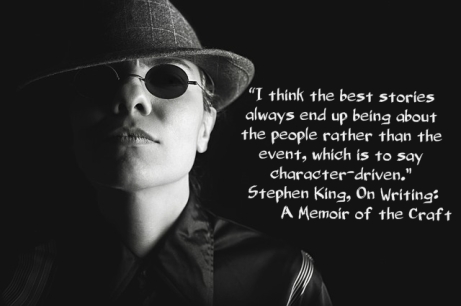Hi friends! It is a pleasure to join you here on Quills and Inkblots today. Thank you, Jebraun, for the invite.
Writing has been my coping mechanism for life from the first days I discovered pen and paper. Although I wrote my first 365 page novel in seventh grade (probably in size 24 font), I never dreamed I would actually pursue writing as a career later in life. In fact, my Bachelor and Masters degrees are in Elementary Education.
You would think a teacher whose classes focused on reading and writing would know how to craft a book. Ha! Joke’s on me. When God called me out of my closet-writing to pursue His dream for me, I discovered not only was I a complete novice, but also the world of writing craft books is large and daunting.
While there are many great books out there, I really want to recommend two books that are quick, easy reads that will challenge any writer no matter their skill level.

(Image from pixbay.com, Meme created by Crystal Caudill)
Getting into Character
No matter what kind of story you write, characters are what draw your reader in. Even the best plots fall flat when characters are unbelievable or lack an emotional connection to the reader.
The Story Equation by Susan May Warren is my go-to book when first developing a story idea. Using her method not only helps me to create an overall well-thought out plot, but it also helps me to develop compelling characters. While her method to creating characters may seem formulaic, every character is as unique as the people God place on this earth.
The formula essentially is one question asked of your character and fully fleshed out to reveal a whole, complex person. It is so simple, yet so complicated. Here, let me just ask the question of you.

Who are you?
Careful, no need to delve into the philosophical depths of that just yet. Susie suggests starting with a noun and an adjective that describes your character as they walk onto the page.
The adjective is used to identify the emotional state of the character while the noun identifies the physical state – such as their job, skill set, or competency.
For example – Determined Engraver (I’m a historical fiction writer, so think 1880s.)
From here we turn into a perpetual two-year-old and ask why until our head hurts.
Why are you a determined engraver?
I’m an engraver because it is the only job Grandfather would allow me to do that would help the print shop stay profitable. With all Grandfather’s creditors dogging us, I use every resource I can to raise money and pay them off – despite Grandfather’s refusal to acknowledge I am saving us from the poor house.
Why doesn’t he acknowledge your help?
Ha! Like he’d ever accept I am anything but a burden to him.
Why are you a burden to him?
… And the questioning goes on and on, until you reach the heart of your character and a dark moment story.

(image from pixbay.com)
Digging in the Dark
We all have moments in our lives that defined us, molded our beliefs about the world around us and about who we are. Your character is no different. Susie calls the Dark Moment Story “the secret sauce behind all the stuff that your character does.”
Mining out their story will help you to identify:
- what lies they believe
- their greatest desire
- their greatest fear
- their wound
- their values
- their noble quest
- their flaws
All of these elements work together to create complex characters that readers connect with and invest in following. While a good writer will not explicitly describe the elements above, they will allow their characters to demonstrate the above through their actions, relationships, and speech. And at some point down the road that Dark Moment Story will be shared with a fellow character and give them a sort of release from it’s grasp.
But before they can fully escape the lies, wounds, and fears created by the Dark Moment Story, they must face a Black Moment Event that relates, even loosely to that story.
Not only does Susie thoroughly explain all of these elements and how to create them in her book, but she also explains how to successfully interweaving them into the plot of your story. What I spent about 500 words explaining doesn’t even scratch the surface of all the wonderful information in this resource. For me, this book is a must have on my writer’s resource shelf.
And if the book isn’t enough for you, Susie does have a monthly subscription program called Novel.Academy that has video lessons and oh so many resources. I highly recommend this if you are an auditory or visual person. Not to mention there are weekly Pep Talks where you get to interact with her and others of the Novel.Academy community.

Looking in the Mirror
Whether plot-driven or character-driven, all books follow the same structure: Act 1 (Beginning), Act 2 (Middle), Act 3 (End). I know, earth shattering information, right? In James Scott Bell’s Write Your Novel from the Middle, he examined the absolute mid-point of books and movies. What he discovered was a not just a scene, but an actual moment that reveals what the whole book or movie was really about. Bell calls this the Mirror Moment.

(image from pixaby.com)
This is the moment in the story where the character looks at himself and takes stock of where he is in the conflict. What is he becoming? How does he have to change to be victorious? What are the odds against them? No matter if the the story is character or plot driven, the main character is facing certain physical, professional, or psychological death. It forces that moment where your character transforms and the reader sees what the story is really all about.
Go ahead, give it a try. I’ll wait. Pick up your favorite book or turn on your favorite movie, and then explore the mid-point.
Did you really do it? No? Come on, humor me, besides I need to grab some dark chocolate and a cup of tea. It’s been a really long week.
…
…
…
Back yet? Great! Did you see it, too? Totally mind blowing how it works. I highly recommend picking up a copy of Write Your Novel from the Middle. Bell does a great job of revealing how knowing this moment impacts your story and how to better plot your book (even if you’re a panster) with this moment in mind.
There are many great writing craft books out there, but honestly, these two are my favorite. Regardless of if you check them out, I hope you will seek our resources that will help you grow as a writer, no matter how many books you have published.
What about creating characters is hardest for you? Do you have a particular method you use? Anything in the information above that struck your fancy or intrigued you? Comment below to join the conversation.

Crystal Caudill is a tea-drinking, book-hoarding, history nerd. Her parents had no idea what a monster they would create when they took her to her first history museum. From that moment on she has been researching and crafting stories that delve into the complicated nature of 18th and 19th century U.S. History. She is a member of American Christian Fiction Writers, ACFW Kentucky Chapter, Seekerville, Novel.Academy, several critique groups, and has a Masters degree in Elementary Education.
You can connect with Crystal Caudill at:
https://www.facebook.com/crystalcaudillauthor/
www.twitter.com/ccaudillwrites/
https://www.pinterest.com/ccaudillky/


Thanks, Crystal, for sharing these great resources! (hurries to put them on an Amazon wishlist) ☺
LikeLiked by 2 people
I’m going to as well! And what was the name of that book you recommended to me…something about pantsers vs plotters?
LikeLike
Take Off Your Pants by Libbie Hawker is the one I’ve been using.☺
LikeLiked by 2 people
Thanks! Sorry, I am behind on checking the blog. I hope they are as helpful to you as they were to me!
LikeLike
Loved, loved. loved this post, Crystal! Great resources! Thank you so much for engaging me, teaching me, and making me laugh!
LikeLiked by 1 person
Glad you enjoyed it! Wasn’t it good!
LikeLiked by 2 people
I love her voice too!
LikeLike
Thanks, Jebraun! I totally lost track of the fact I wouldn’t be notified of comments like I am when posting on my blog! Oops!
LikeLike
So glad it made you laugh and that you learned a little. I certainly have come a long way after reading these books, and I still constantly reference them.
LikeLiked by 1 person
Then those are the best kind of resources!! I need to add them to my personal bookshelf.
LikeLiked by 1 person